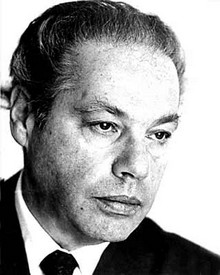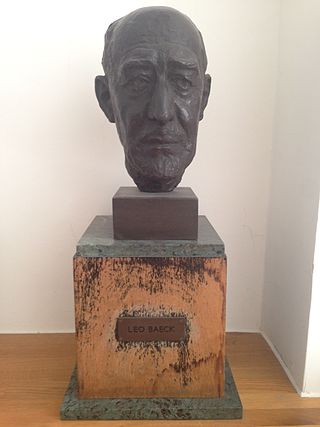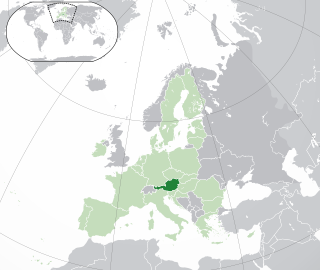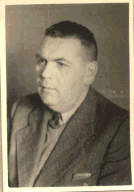Related Research Articles

Alois Brunner was an Austrian officer who held the rank of SS-Hauptsturmführer (captain) during World War II. Brunner played a significant role in the implementation of the Holocaust through rounding up and deporting Jews in occupied Austria, Greece, Macedonia, France, and Slovakia. He was known as Final Solution architect Adolf Eichmann's right-hand man.
Anton "Toni" Burger was a Hauptsturmführer (Captain) in the German Nazi SS, Judenreferent in Greece (1944) and Lagerkommandant of Theresienstadt concentration camp.

Fritz Hochwälder also known as Fritz Hochwaelder, was an Austrian playwright. Known for his spare prose and strong moralist themes, Hochwälder won several literary awards, including the Grand Austrian State Prize for Literature in 1966. Most of his plays were first performed at the Burgtheater in Vienna.

Leo Baeck was a 20th-century German rabbi, scholar, and theologian. He served as leader of Reform Judaism in his native country and internationally, and later represented all German Jews during the Nazi era. After the Second World War, he settled in London, in the United Kingdom, where he served as the chairman of the World Union for Progressive Judaism. In 1955, the Leo Baeck Institute for the study of the history and culture of German-speaking Jewry was established, and Baeck was its first international president. The Leo Baeck Medal has been awarded since 1978 to those who have helped preserve the spirit of German-speaking Jewry in culture, academia, politics, and philanthropy.

Georg Alexander Pick was an Austrian Jewish mathematician who was murdered during The Holocaust. He was born in Vienna to Josefa Schleisinger and Adolf Josef Pick and died at Theresienstadt concentration camp. Today he is best known for Pick's theorem for determining the area of lattice polygons. He published it in an article in 1899; it was popularized when Hugo Dyonizy Steinhaus included it in the 1969 edition of Mathematical Snapshots.

Theresienstadt Ghetto was established by the SS during World War II in the fortress town of Terezín, in the Protectorate of Bohemia and Moravia. Theresienstadt served as a waystation to the extermination camps. Its conditions were deliberately engineered to hasten the death of its prisoners, and the ghetto also served a propaganda role. Unlike other ghettos, the exploitation of forced labor was not economically significant.

The history of the Jews in Austria probably begins with the exodus of Jews from Judea under Roman occupation. There have been Jews in Austria since the 3rd century CE. Over the course of many centuries, the political status of the community rose and fell many times: during certain periods, the Jewish community prospered and enjoyed political equality, and during other periods it suffered pogroms, deportations to concentration camps and mass murder, and antisemitism. The Holocaust drastically reduced the Jewish community in Austria and only 8,140 Jews remained in Austria according to the 2001 census. Today, Austria has a Jewish population of 10,300 which extends to 33,000 if Law of Return is accounted for, meaning having at least one Jewish grandparent.

The Hotel Imperial, also known as The Imperial, is a five-star luxury hotel in Vienna, Austria. It is located on the Vienna Ring Road (Ringstraße) at Kärntner Ring 16, in the Innere Stadt district.

The Hotel Bristol is the name of more than 200 hotels around the world. They range from grand European hotels, such as Hôtel Le Bristol Paris and the Hotel Bristol in Warsaw or Vienna to budget hotels, such as the SRO Bristol in San Francisco. They are not a chain, except in Brazil, where Bristol Hoteis & Resorts has around a dozen hotels throughout the country with the Bristol name.

Siegfried Seidl was an Austrian career officer and World War II commandant of the Theresienstadt concentration camp located in the present-day Czech Republic. He was also the commandant of the Bergen-Belsen, and later served as a staff officer to Adolf Eichmann. After the war, Seidl was tried in Austria and convicted as a war criminal, sentenced to death, and executed by hanging.

Karl Rahm was a Sturmbannführer (major) in the German Schutzstaffel who, from February 1944 to May 1945, served as the commandant of the Theresienstadt concentration camp. Rahm was the third and final commander of the camp, succeeding Siegfried Seidl and Anton Burger. He was hanged for war crimes.

Benjamin Israel Murmelstein was an Austrian rabbi. He was one of 17 community rabbis in Vienna in 1938 and the only one remaining in Vienna by late 1939. An important figure and board member of the Jewish group in Vienna during the early stages of the war, he was also an "Ältester" of the Judenrat in the Theresienstadt concentration camp after 1943. He was the only "Judenältester" to survive the Holocaust and has been credited with saving the lives of thousands of Jews by assisting in their emigration, while also being accused of being a Nazi collaborator.
Unser Wien is a book co-authored by Stephan Templ and Tina Walzer that details how hundreds of Jewish businesses in Vienna were seized by the Nazis and never given back.

The Theresienstadt Papers are a collection of historical documents of the Jewish self-government of Theresienstadt concentration camp. These papers include an "A list" of so-called "prominents" interned in the camp and a "B-list" created by the Jewish Elders themselves. The Theresienstadt papers include two albums with biographies and many photographs, 64 watercolors and drawings from prisoners in Theresiendstadt, and the annual report of the Theresienstadt Central Library. The papers were preserved at the liberation of the camp in May 1945 by Theresienstadt librarian Käthe Starke-Goldschmidt and later loaned to the Altona Museum for Art and Cultural History in Hamburg by her son Pit Goldschmidt. The collection was opened for viewing by the public in 2002 at the Heine Haus branch of the Altona Museum.
Leo Luster (1927–2017) was an Austrian Holocaust survivor. He was taken to Theresienstadt Ghetto in 1942 and deported to Auschwitz concentration camp in 1944. After the Holocaust, Luster moved to Israel and served on the Central Council of Jews from Austria in Israel.

Rudolf Gelbard was an Austrian Holocaust survivor and political campaigner against anti-Semitism and neo-Nazism. He lectured in schools and universities about his experiences during the Holocaust, and also appeared in a 2007 documentary film about his experiences.
The Holocaust in Austria was the systematic persecution, plunder and extermination of Jews by German and Austrian Nazis from 1938 to 1945. Part of the wider-Holocaust, pervasive persecution of Jews was immediate after the German annexation of Austria, known as the Anschluss. An estimated 65,000 Jews were murdered and 125,000 forced to flee Austria as refugees.
Heinrich Rieger was an Austrian dentist whose art collection was one of the most important in Austrian modern art. Rieger and his wife were murdered in the Holocaust.
References
- ↑ Erlanger, Steven (March 7, 2002). "Vienna Skewered as a Nazi-Era Pillager of Its Jews". New York Times.
- ↑ Spivak, Rhonda (October 14, 2014). "the Imperial Hotel-Where Hitler Stayed When In Vienna After the Anschluss". Winnipeg Jewish Review.
- ↑ "SCHALLINGER SAMUEL: TODESFALLANZEIGE, GHETTO THERESIENSTADT". Nationalarchiv Prag; Institut Theresienstädter Initiative.
- ↑ Connolly, Kate (May 21, 2002). "Vienna's tourist trail of plunder". The Guardian.